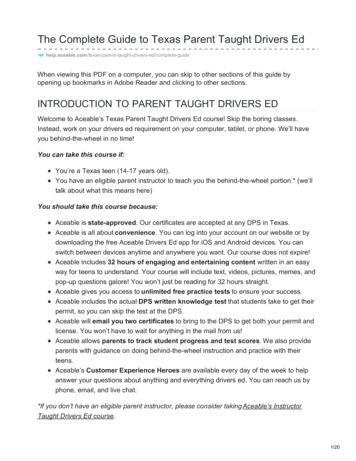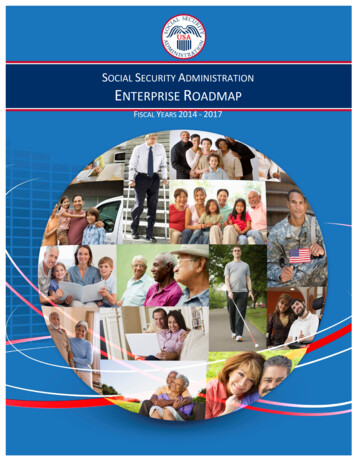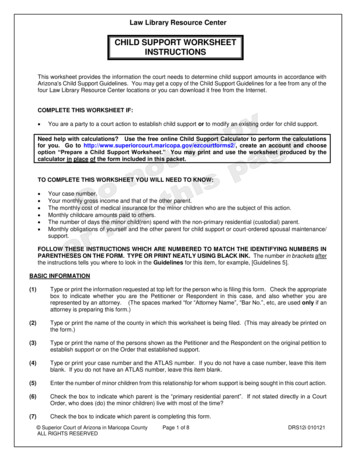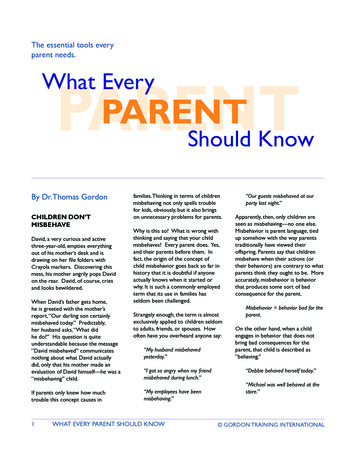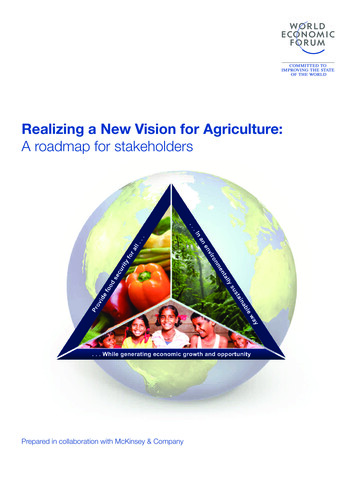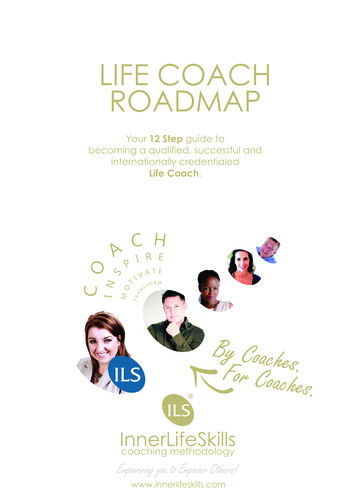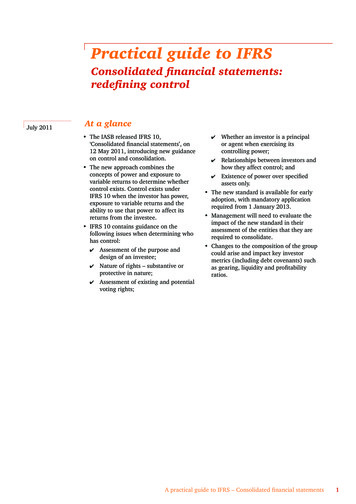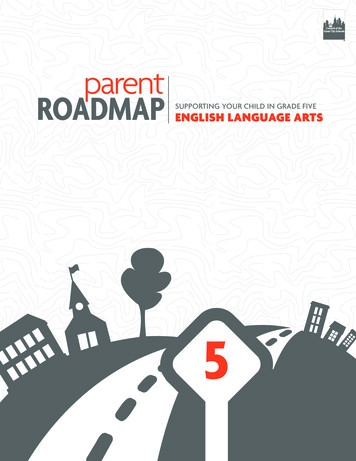
Transcription
TMparentROADMAPSUPPORTING YOUR CHILD IN GRADE FIVEENGLISH LANGUAGE ARTS5
America’s schoolsare workingto provide higherquality instructionthan ever before.The way we taught students in the past simply does not preparethem for the higher demands of college and careers today and in thefuture. Your school and schools throughout the country are working toimprove teaching and learning to ensure that all children will graduatehigh school with the skills they need to be successful.In English language arts and literacy, this means three major changes.Students will continue reading and writing. But in addition to storiesand literature, they will read more texts that provide facts andbackground knowledge in areas including science and social studies.They will read more challenging texts and be asked more questionsthat will require them to refer back to what they have read. There willalso be an increased emphasis on building a strong vocabulary so thatstudents can read and understand challenging material.SUPPORTING YOUR CHILD IN GRADE FIVE ENGLISH LANGUAGE ARTS1
What your child will belearning in grade fiveEnglish language artsand literacyIn grade five, students will continue to build important reading, writing,speaking, and listening skills. They will read more challenging literature,articles, and other sources of information and continue to grow theirvocabulary. Students will also be expected to understand and clearlysummarize what they have learned from readings and classroomdiscussions, referring to specific evidence and details from the text.Students will write regularly and continue to develop their ability togather, organize, interpret, and present information. Activities in theseareas will include: Determining the theme of a story, play, or poem, including howcharacters respond to challenges Comparing and contrasting stories that deal with similar themes ortopics Explaining how authors use reasons and evidence to support theirpoints or ideas Drawing on information from multiple books, articles, or onlinesources to locate an answer or to solve a problem quickly Learning the rules of spoken and written English Learning and using new words, including words related to specificsubjects (such as science words) Understanding figurative language Participating in class discussions by listening, asking questions, sharingideas, and building on the ideas of others Giving a class presentation on a topic or telling a story, introducingrelevant facts and details in a clear, logical order Writing research or opinion papers over extended periods of timeFor example, “She was as quiet as a mouse.”Partneringwith yourchild’s teacherDon’t be afraid to reach out to your child’s teacher—you are an importantpart of your child’s education. Ask to see a sample of your child’s work orbring a sample with you. Ask the teacher questions like: Is my child at the level where he/she should be at this point of theschool year? What do you think is giving my child the most trouble? How can I helpmy child improve in this area? Where is my child excelling? How can I support this success?SUPPORTING YOUR CHILD IN GRADE FIVE ENGLISH LANGUAGE ARTS2
In grade five, students will read a wide range of literature, including stories, plays,and poems. Additionally, they will read to learn information about history, the world,science, and other areas. Here are just a few examples of how your child will developimportant reading skills across grade levels.READING LITERATUREGrade Four ReadingGrade Five ReadingGrade Six Reading Students determine the themeof a story, play, or poemfrom details in the text andsummarize the text. Students determine the themeof a story, play, or poem fromdetails in the text, including howcharacters respond to challengesor how the speaker in a poemreflects upon a topic, andstudents summarize the text. Students determine the themeor central idea of a text and howit is conveyed through particulardetails and provide a summaryof the text without personalopinions or judgments. Students compare and contrastthe point of view fromwhich different stories aretold, including the differencebetween first- and third-personaccounts. Students describe how anarrator’s or speaker’s point ofview influences how events aredescribed. Students explain how an authordevelops the point of view ofthe narrator or speaker in a text.READING FOR INFORMATIONGrade Four ReadingGrade Five ReadingGrade Six Reading Students refer to detailsand examples in a text whenexplaining what the text saysexplicitly and when drawinginferences from the text. Students quote accurately froma text when explaining what thetext says explicitly and whendrawing inferences from the text. Students cite evidence fromthe text to support analysis ofwhat the text says explicitly aswell as inferences drawn fromthe text. Students interpret informationpresented in charts, graphs,or other visual sources ofinformation and explain howthe information contributes toan understanding of the text. Students draw on informationfrom multiple print or digitalsources, demonstrating theability to locate an answer to aquestion quickly or to solve aproblem efficiently. Students integrate informationpresented in different mediaor formats (such as visually orthrough numbers) as well as inwords to develop a coherentunderstanding of a topic or issue.As they progress through grade levels, students will be asked more questions that require themto cite details or information from increasingly challenging texts. This will encourage them tobecome observant and analytical readers.SUPPORTING YOUR CHILD IN GRADE FIVE ENGLISH LANGUAGE ARTS3
Writing tasks in grade five may include stories, essays, reports, and persuasive papers.Here are just a few examples of how your child will develop important writing skillsacross grade levels. Grade Four WritingGrade Five WritingGrade Six Writing Students introduce a topic clearlyand develop the topic with facts,definitions, concrete details,quotations, or other information. S tudents introduce a topic clearly,providing a general observationand focus, and develop the topicwith facts, definitions, concretedetails, quotations, or otherinformation. Students introduce a topic anddevelop the topic with relevantfacts, definitions, concrete details,quotations, or other information. Students provide a concludingstatement or section related tothe information or explanationpresented. Students group relatedinformation in paragraphs andsections and use formatting (suchas headings), illustrations, andmultimedia when useful. Students link ideas withincategories of informationusing words and phrases (suchas another, for example, also,and because). Students use precise language andsubject-specific vocabulary. S tudents provide a concludingstatement or section related tothe information or explanationpresented. S tudents group relatedinformation logically and useformatting (such as headings),illustrations, and multimedia whenuseful. S tudents link ideas within andacross categories of informationusing words, phrases, and clauses(such as in contrast or especially). S tudents use precise language andsubject-specific vocabulary. Students provide a concludingstatement or section thatfollows from the information orexplanation presented. Students organize ideas, concepts,and information using strategiessuch as definition, classification,comparison/contrast, and cause/effect. Students include formatting (suchas headings), graphics (such ascharts or tables), and multimediawhen useful. Students use appropriate transitionsto clarify the relationships amongideas and concepts. Students use precise language andsubject-specific vocabulary. Students establish and maintain aformal writing style.Some writing guidelines may seem similar from year to year. However, with practice ateach grade level, students continue to learn and apply the rules of standard written Englishand to strengthen and expand their vocabulary, use of language, and organization of ideas.SUPPORTING YOUR CHILD IN GRADE FIVE ENGLISH LANGUAGE ARTS4
Helping your childlearn outside of school1. Provide time and space for your child to read independently. Thistime should be free from distractions such as television.2. Ask your child what he or she learned from reading. Have him or herread the most interesting or useful sections aloud, and discuss howthat knowledge can be used in real life.3. Assist your child in using references such as the Internet or adictionary to look up unfamiliar words.4. Keep track of the time that your child spends reading every day.Note what kind of reading materials he or she likes (books, magazines,newspaper articles, the Internet, etc.). Then look for additionalmaterials that would encourage your child to read more.5. Be sure your child has a library card. Children should select booksthey are interested in to develop a passion for reading. Many librarieshave book clubs and family activities that make reading fun for theentire family.6. Use technology to help build your child’s interest in reading. Thereare several websites where students can read books or articlesonline. The computer will help with words the student cannotread independently. Libraries also have computers students canuse to access those sites. Feel free to ask a librarian or teacher forsuggestions.Additional ResourcesNFor more information on the Common Core State Standards for Englishlanguage arts and literacy, go to y-points-in-english-language-arts or http://www.commoncoreworks.org.EWSSUPPORTING YOUR CHILD IN GRADE FIVE ENGLISH LANGUAGE ARTS
background knowledge in areas including science and social studies. They will read more challenging texts and be asked more questions that will require them to refer back to what they have read. There will also be an increased emphasis on building a strong vocabulary so that students can read and understand challenging material. America's schools
